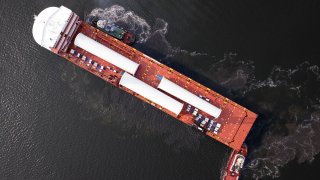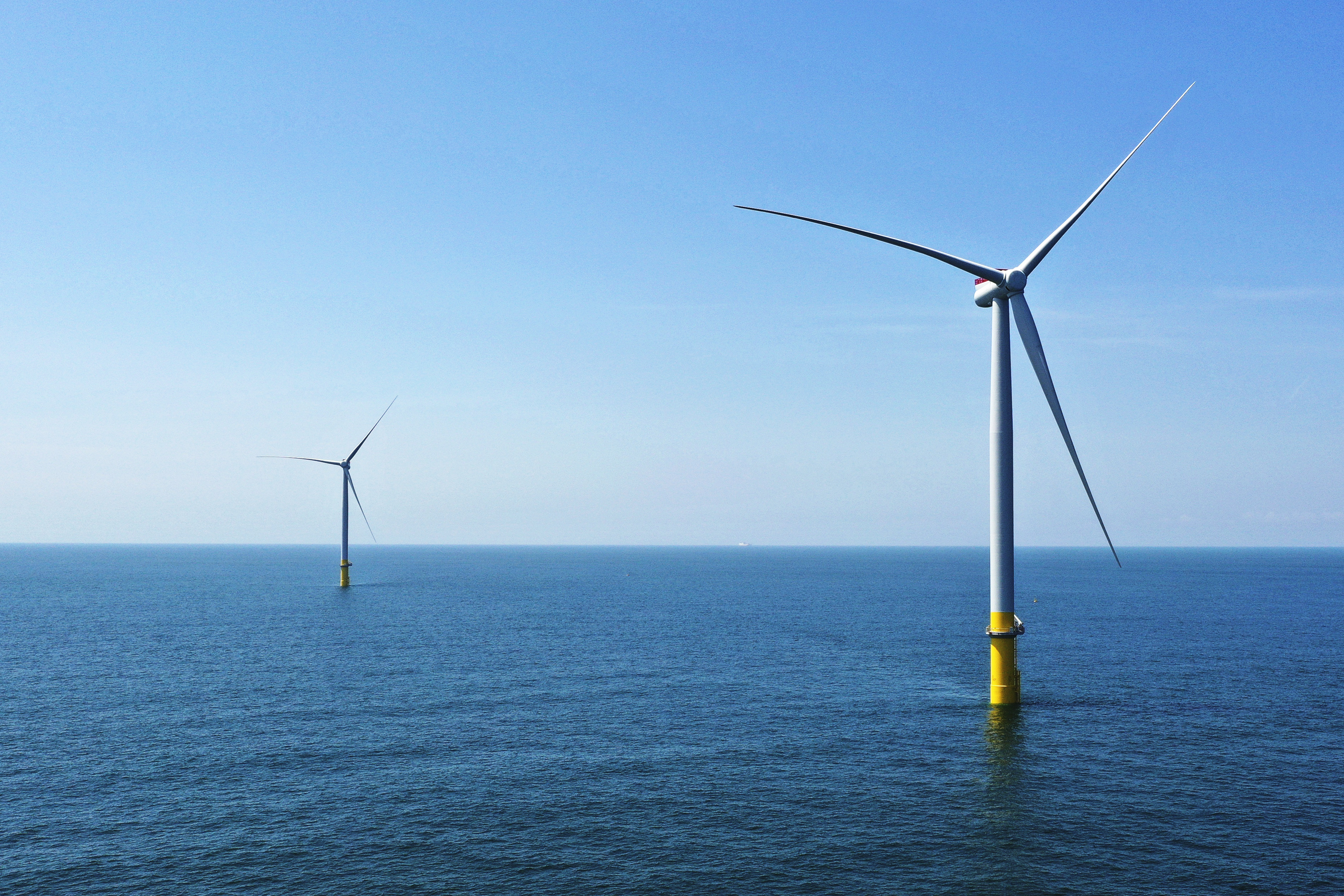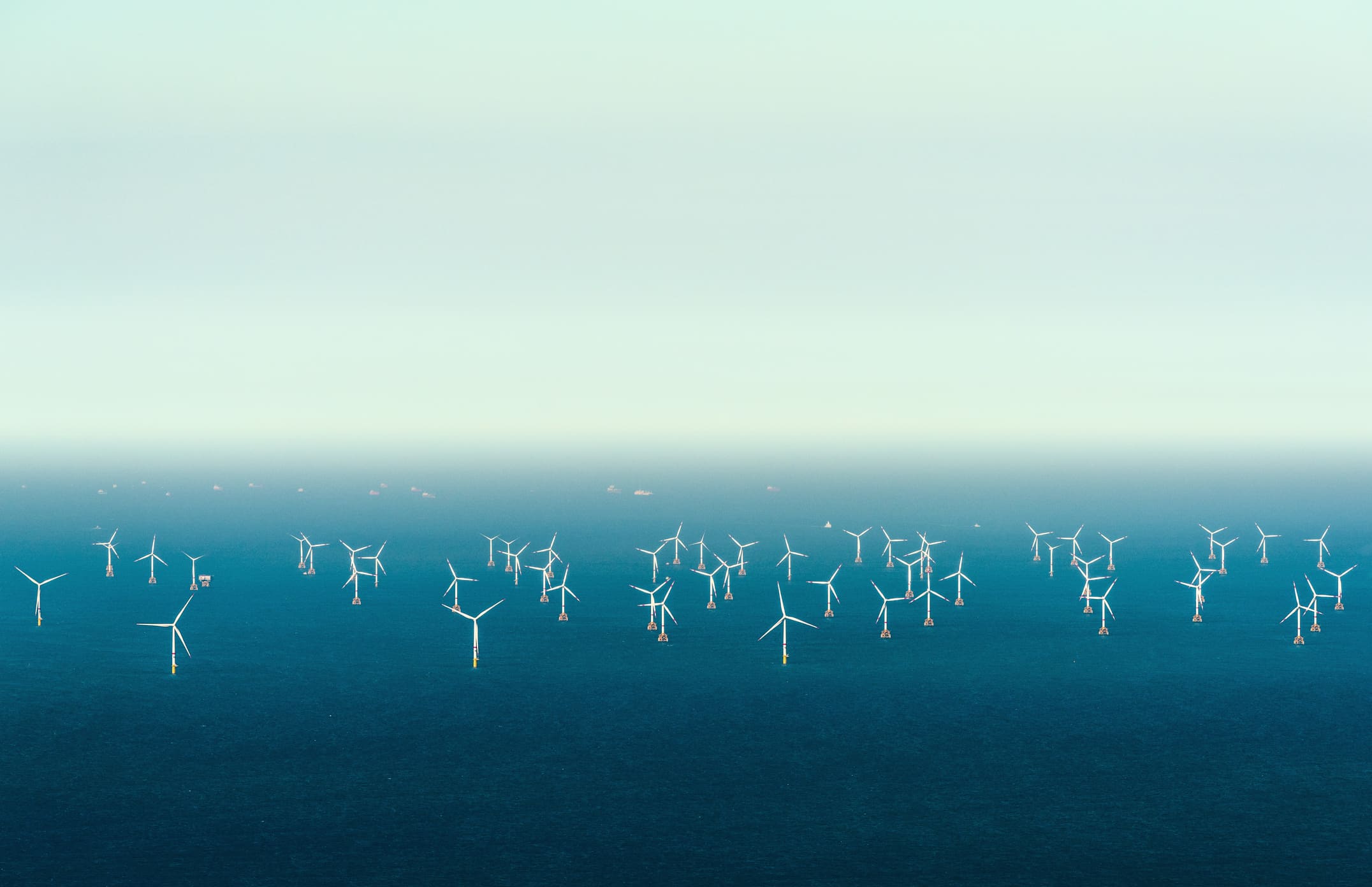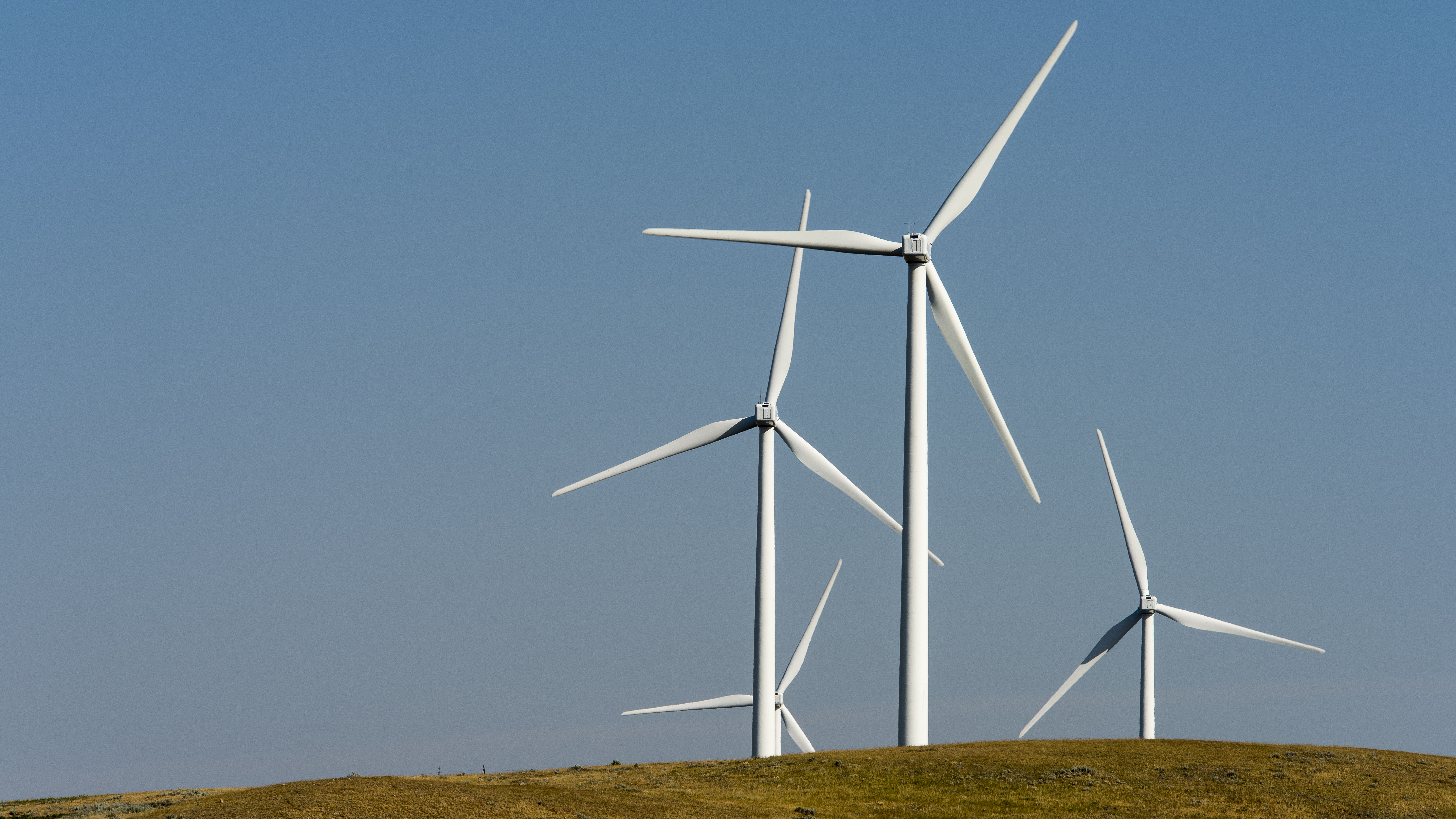
The first clean wind power generated by the Vineyard Wind 1 project is expected to flow onto the regional grid by mid-October and the first-in-the-nation offshore wind project should be fully operational by this time next year, project officials said Wednesday during a boat tour of the construction.
Project developers have maintained for years that the $4 billion project they are building about 15 miles south of Martha's Vineyard would start to generate cleaner energy by the end of 2023, but they told a group of state lawmakers, clean energy advocates, organized labor representatives and others Wednesday that the target is now mid-October, or just over two months from now.
At first, the project will send power generated by a string of six turbines onto the grid, totaling about 78 megawatts, with plans to ramp the project up to between 200 and 300 MW by the end of the year and full commercial operations of 806 MW expected by mid-2024, according to Sy Oytan, Avangrid's chief operating officer for offshore wind.
Vineyard Wind, a joint venture between Avangrid and Copenhagen Infrastructure Partners, began offshore construction activities in June by setting the foundations for the 62 turbines that will make up the 806-megawatt project that has been years in the making.
Get New England news, weather forecasts and entertainment stories to your inbox. Sign up for NECN newsletters.
On Wednesday, about 15 representatives and two senators were among those who got to see the progress of that construction from aboard the Captain John and Son II, which was chartered for the tour by Avangrid, the Environmental League of Massachusetts and the New England for Offshore Wind Coalition.
When they are fully assembled, each of Vineyard Wind 1's 62 turbines will stretch about 850 feet above the Atlantic Ocean -- taller than any building in New England. There was not much to see in the way of towers or turbines Wednesday -- those on the boat tour saw a series of foundations with "transition pieces" sticking up out of the water, each arranged one nautical mile away from others in a grid pattern.
More visually interesting was the offshore substation that Oytan said is the first to be installed in the United States. Each turbine will eventually connect into the substation, which accounts for about $900 million of the $4 billion project cost. Oytan said the facility will take power in at 66 kilovolts from each turbine and step up the voltage to 220 kV before sending it over an export cable that will connect to the regional power grid in Barnstable.
"One of the takeaways for me is that determination and follow-through is the name of the game. This fight to save the planet and create clean wind is literally the work of our lifetime. But how wonderful it is to realize that you can actually win. That's what we're seeing today," Sen. Michael Barrett, who co-chairs the Joint Committee on Telecommunications, Utilities and Energy, said. "All you hear about, and understandably, is how tough the climate problem is. And of course it's every bit as tough as people say. Today, we're gaining ground, we're pushing back we're making genuine progress."
Once it is fully operational, Vineyard Wind 1 is projected to generate cleaner electricity for more than 400,000 homes and businesses in Massachusetts, produce at least 3,600 jobs, reduce costs for Massachusetts ratepayers by an estimated $1.4 billion over 20 years, and eliminate 1.68 million metric tons of carbon dioxide emissions annually.
For Rep. Jeff Roy of Franklin, who handles offshore wind policy for the House as co-chair of the Joint Committee on Telecommunications, Utilities and Energy, it was the gargantuan effort in the 1920s to marshal government and industry to power the western states by building the Hoover Dam that came to mind.
"When I look out at what we saw today ... we're looking at our generation's Hoover Dam, right here off the coast of Massachusetts," Roy said. "This power is going to provide the energy independence that we have long wanted and needed for the commonwealth of Massachusetts, and it's also going to provide the robust clean energy source that we need to make the transition to fossil fuel-free by 2050."
Activity on the water
Aboard the Captain John and Son II, the trip out to the Vineyard Wind lease area took about two hours. The lawmakers, staffers and advocates onboard took advantage of the time to enjoy the sun, chat about the recent flurry of legislative activity and share news on various summer plans.
Early in its journey, the boat tour took attendees close to the site proposed for the 130-turbine wind farm known as Cape Wind, which won federal approval in 2010 and was expected for a time to be the first offshore wind development in the country. That project was never built, largely due to opposition to its location at Horseshoe Shoal within Nantucket Sound.
The Vineyard Wind 1 project will be located in federal waters about 15 miles south of Martha's Vineyard and Nantucket. The project's lease area is adjacent to where other developers are also preparing their own wind energy projects. Project officials said Vineyard Wind 1's turbines will not be visible from land, even on the clearest of days.
The first sign of construction activities was a ship that was working to connect joints in the export cable that will carry Vineyard Wind 1's power from the substation to Barnstable. About 40 miles of cable (of about 98 miles total) has been installed, Oytan said, and the onshore work necessary to accept the export cable is complete.
There was very little activity in the wind lease area, though there was plenty of wind. Oytan said the relatively shallow waters off of Massachusetts are "the premium place in the world for offshore wind production" because of the combination of ocean depths of about 100 feet, which allows for construction, and wind speeds of up to 36 feet per second.
Next week, Oytan said, workers will begin to install the towers that soar hundreds of feet skyward from the foundations, followed by installation of the energy generation components and lastly installation of the three 351-foot blades that will catch the wind and turn the turbine.
The first of a new industry
As the first utility-scale offshore wind project in the United States, Vineyard Wind 1 is at the front edge of a growing new industry that Massachusetts policymakers hope will be an economic engine in the Bay State -- not to mention a key contributor to decarbonization efforts.
During the project's development phase between 2017 and 2021, direct Vineyard Wind employment in Massachusetts was 278 full-time equivalent job years. The payroll for those jobs and the project's other expenditures supported an additional 137 indirect jobs during development. In turn, the direct and indirect jobs induced an additional 251 jobs in development, a report to the Massachusetts Department of Energy Resources found.
The development phase -- which was longer than anticipated due to federal delays -- generated 666 jobs, $59.3 million in labor income, $79.1 million in value added, and $166.6 million in economic output, according to the report from UMass Dartmouth and Spring Line Research.
More wind farm news
There was little active construction taking place at the lease area on Wednesday since the vessel that does the actual installation of monopiles was away making a trip to Halifax, Nova Scotia, to pick up additional supplies. But about 25 to 30 people were working on the project offshore presently, including 16 union piledrivers, Oytan said. He said those workers spend two or three weeks offshore at a time, sleeping on an "accommodation vessel."
In July 2021, Vineyard Wind signed a project labor agreement with the Southeastern Massachusetts Building Trades Council to guarantee that at least 500 union workers will have a hand in building the country's first significant offshore wind farm.
The continued development of the offshore wind sector is seen as crucial to meeting the new climate goals Massachusetts has adopted, specifically the requirement to achieve net-zero carbon emissions by 2050.
Vineyard Wind 1 was the first offshore wind project selected by Massachusetts utility companies with input from the Baker administration to fulfill part of a 2016 clean energy law, and is likely to be the only Massachusetts offshore wind project to become a reality until at least 2028 as subsequent projects have run into economic headwinds that developers say threaten their ability to finance their projects.
Both projects, including the Commonwealth Wind project that Avangrid is also behind, are seeking to terminate contracts they already agreed to with plans to bid the same projects at higher prices in the state's next round of offshore wind procurement next year.
The Long and Winding Road
That Vineyard Wind 1 would be constructed at all has not always been a sure thing and the project has had to navigate chopppy waters to get to this point.
Project developers originally planned to financially close on the project and begin on-shore construction work in 2019, put the first turbine into the seabed in 2021 and begin generating electricity in 2022.
But under the Trump administration, the U.S. Bureau of Ocean Energy Management in the summer of 2019 decided to undertake a broad study of the potential impacts of offshore wind projects planned up and down the East Coast, holding up a key permit approval for Vineyard Wind 1.
After meetings between the U.S. Department of the Interior, Baker and members of the Congressional delegation proved fruitless, Vineyard Wind announced on Dec. 1 of that year that it was pulling its project out of the federal review pipeline. The Trump administration declared the federal review of the project "terminated."
But Vineyard Wind's decision to yank its plan from review also meant the project's ultimate fate would not be decided under Trump, who frequently expressed concerns about wind power and held the project back while his administration looked into impacts that the burgeoning industry could have on commercial fishing.
Less than a month into Joe Biden's presidency, in February 2021, the Bureau of Ocean Energy Management announced that it was resuming the federal review of the Vineyard Wind 1 project from the point at which the developer withdrew it. By May, the Biden administration had approved the project's construction and operations plan and cleared the way for construction to begin.
Sign up for our Breaking newsletter to get the most urgent news stories in your inbox.




